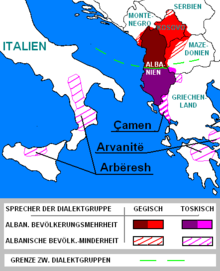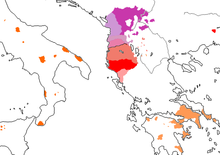Albanian language
![]()
Albanian is a redirect to this article. For other meanings, see Albanian (disambiguation).
The Albanian language (proper name gjuha shqipe [ˈɟuha ˈʃcipɛ]) belongs to the Balkan Indo-European language group of the Indo-European language family and the Balkan Language Union. It has been documented in writing since the 15th century and is today an official language in Albania, Kosovo and northern Macedonia, as well as a minority language in other countries of southeastern Europe and in Italy.
Albanian has two major dialect groups, Gegean in the north and Tuscan in the south, which can be subdivided into local sub-dialects, some of which are very different (see Albanian dialects). Today's written Albanian language was developed only in the middle of the 20th century on the basis of the Tuscan dialect group. In 1972 this process came to a conclusion at a congress in Tirana. For some years now, there have been calls for greater consideration of Gaelic variants in language policy.
The Albanian vocabulary adopted loanwords from Ancient Greek, then from Latin; borrowings from South Slavic, (Middle) Greek and Turkish, Italian and French and other languages followed. Currently, Anglicisms are increasingly being added.
Distribution
See also: List of Albanian population shares by state
The closed Albanian-speaking area on the Balkan Peninsula includes Albania, Kosovo, the western and northwestern parts of northern Macedonia, northwestern Greece, as well as some bordering areas in Serbia and Montenegro. Ancient Albanian-speaking minorities live in southern Italy and Sicily (see Arbëresh) and in the Peloponnese, Attica, and other southern Greek regions and islands (see Arvanites). In addition, Albanians lived in southern Epirus until a few decades ago (see Çamen). There are also smaller minorities in Bulgaria (Mandriza), Romania (Bucharest, Timișoara, Iași, Constanța, Cluj-Napoca) and Ukraine (Zaporizhzhya Oblast and Bochak).
In total, more than 7.2 million people speak the Albanian language, including about 2.5 million in Albania, about 2.6 million in the other Balkan countries, and more than two million emigrants worldwide.

Distribution of the Albanian language in South and Southeast Europe
Dialects
The Central Albanian river Shkumbin divides the Albanian-speaking area into a northern Gaegean zone and a southern Tuscan zone. Along the river also exists a transitional zone, which is about 15 to 20 kilometers wide. During the Rilindja, two written Albanian languages emerged for the Tuscan and the Ghegan dialects. Today's standard Albanian language, which was unified in 1972, is largely based on the northern Tuscan dialect with some Ghenish elements.
Differences
The two main dialects differ phonetically, morphologically and also lexically. The phonetic differences are minor, for example the nasal â [ɑ] of Gegean and the ë [ə] of Tuscan (nâna - nëna 'the mother') or also the Gegean n with the Tuscan r (syni - syri 'the eye'). Another difference is that words which have a 'q' in Tuscan become a 'k' in the Anglican (qesh - kesh 'laugh').
The morphological differences are all the more numerous, for example, the Opposite has an infinitive, which Tuscan lacks. Moreover, the future tense is formed in Gegean with the conjugated verb 'to have' (in Gegean me pâs) and the infinitive, whereas in Tuscan this is done via an unconjugable form of the verb 'to want' (do) with a relative clause containing the verb to be placed in the future tense in conjugated form in the present tense. This subordinate clause is introduced by the subjunction të. An example of this is unë do të shkoj for 'I will go'.
The vocabulary of the two main dialects differs in part even in words for everyday things, so 'milk' is called tâmbël in Gegean, but qumësht in Tuscan. 'Village' is katûn in Gegean, fshat in Tuscan. 'Fox' is skile or shpin in Gegean, and dhelpër in Tuscan. Also g. bërshê(n) opposite t. (v)enjë 'stink juniper; yew', rrêj - gënjej 'lie', krejt - fare 'whole', or shpullë - pëllëmbë 'palm'.
Geographical subdivision
- Gegisch
- Northwest Georgian in northwest Albania and in all Albanian municipalities in Montenegro (near Bar and Ulcinj)
- Northeastern Georgian in Kosovo, Northeastern Albania, in all Albanian municipalities in Serbia and in the areas around Skopje, Kumanovo, Tetovo and Gostivar in Northwestern Macedonia.
- Central Georgian in the Mirdita, northern central Albania (Tirana, Durrës and Peshkopia) and southwestern Macedonia (Debar and Struga).
- South Georgian in Central Albania (Kavaja to Elbasan)
- Gegisch-Toskian transition zone on the Shkumbin (about 20 kilometres wide, including Shpat and Sulova)
- Tuscan
- Northern Tuscan in the area between Vlora, Lushnja, Pogradec and Bilisht as well as within Northern Macedonia in many villages at Lake Ohrid and Lake Prespa and as language islands scattered in the regions of Bitola, Kruševo and Dolneni.
- Labish-Tuscan on the Albanian Riviera as far as Piqeras and from Vlora across the Vjosa Valley to Tepelena (until here Labëria) as well as Përmet and in the east in the regions of Leskovik and Erseka.
- Çamish-Tuscan in southernmost Albania (Gjirokastra and Saranda) and formerly also in the eponymous Çamëria in northwestern Greece
- Arbëresh-Tuscan in some regions in southern Italy (including Sicily)
- Arvanite-Tuscan in many settlements in central and southern Greece (but usually considered a single language).

Dialect zones in Albania and their foreign language islands
Search within the encyclopedia